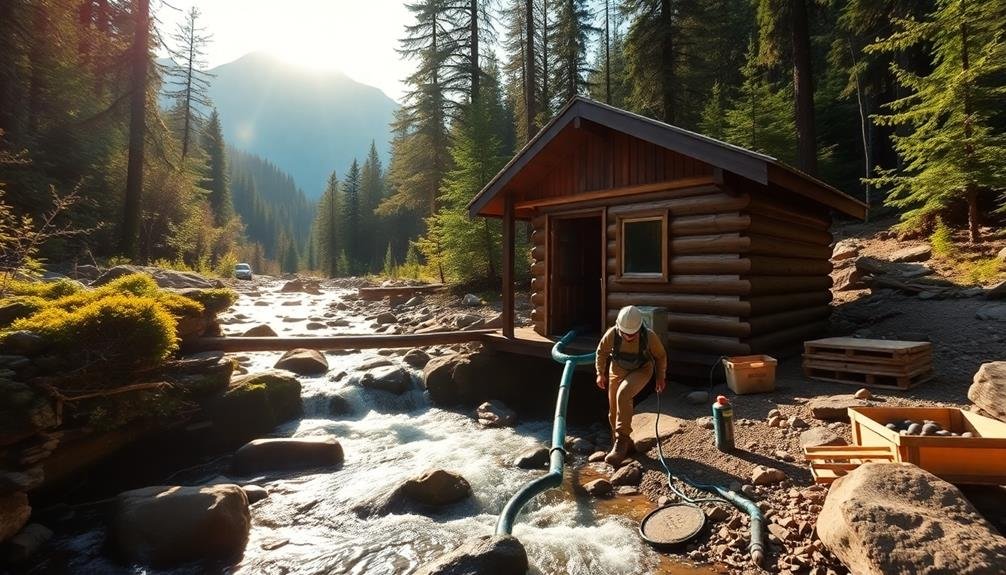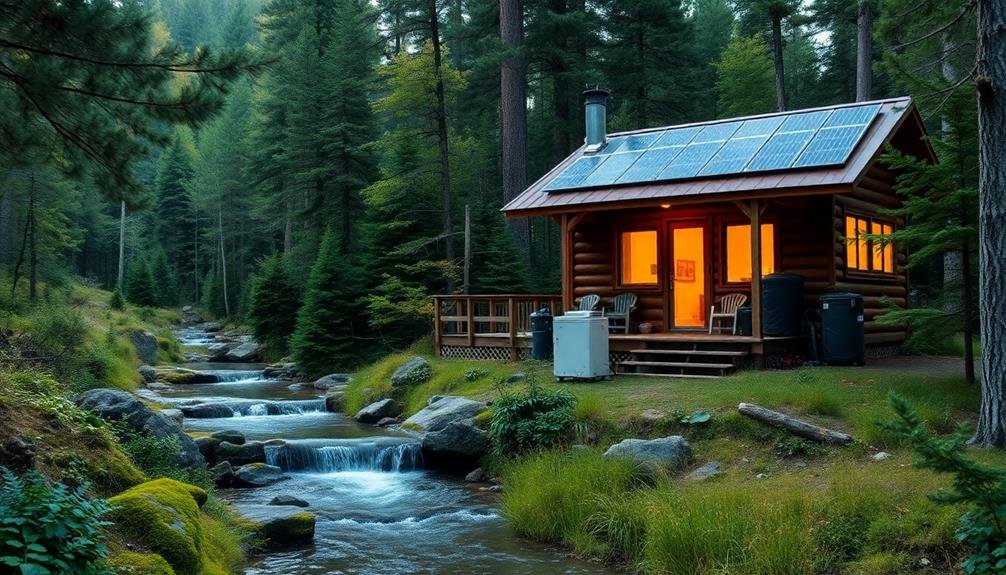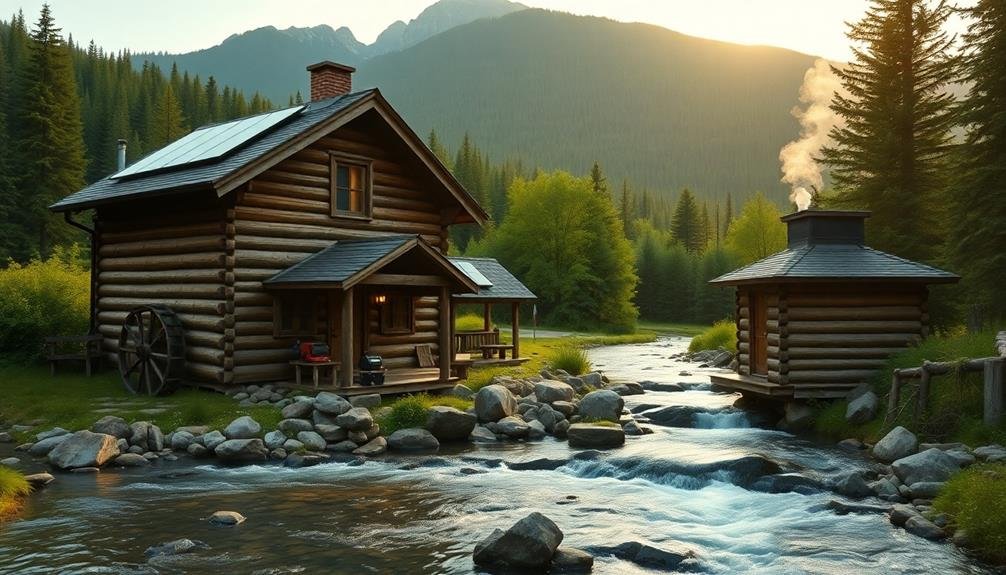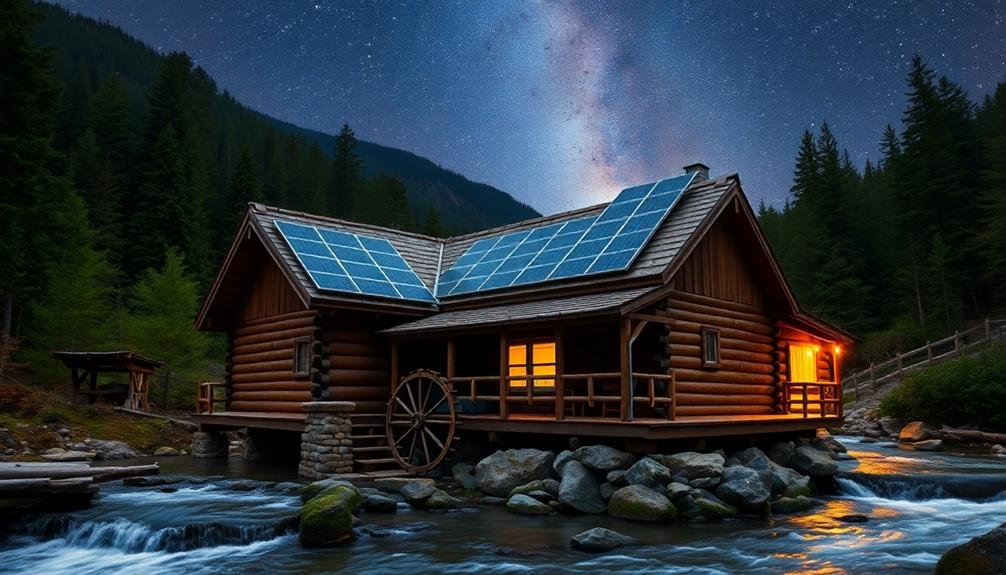Micro-hydro power systems offer a sustainable solution for powering off-grid remote homes. You'll harness flowing water to generate electricity, typically producing under 100 kW. To start, assess your property's water resources, considering flow rate and vertical drop. Key components include an intake, penstock, turbine, and generator. You'll need to design the system based on your site's unique characteristics and integrate it with existing power setups. Don't forget to account for seasonal variations and explore energy storage options. While initial costs can range from $5,000 to $50,000, these systems often pay for themselves within 5-10 years. Dive deeper to uncover the full potential of micro-hydro power for your remote home.
Understanding Micro-Hydro Power Systems

What exactly is a micro-hydro power system? It's a small-scale hydroelectric power system that converts the energy from flowing water into electricity. Unlike large hydroelectric dams, micro-hydro systems are designed for individual homes or small communities, typically producing less than 100 kilowatts of power.
You'll find that micro-hydro systems consist of several key components. First, there's the intake, which diverts water from a stream or river. The water then flows through a pipeline, called a penstock, to the powerhouse. Inside the powerhouse, you'll find a turbine that spins as water flows through it, connected to a generator that produces electricity.
After passing through the turbine, the water is returned to the stream through the tailrace.
To set up a micro-hydro system, you'll need a reliable water source with sufficient flow and head (vertical drop). The amount of power generated depends on these two factors.
You'll also need to take into account environmental impacts, local regulations, and maintenance requirements. While initial costs can be high, micro-hydro systems often provide a sustainable, long-term power solution for off-grid homes in suitable locations.
Assessing Your Property's Water Resources
Evaluating your property's water resources is the essential first step in determining if a micro-hydro system is feasible for your off-grid home.
You'll need to assess two key factors: water flow and head (vertical drop).
To measure water flow, you'll need to calculate the volume of water passing through a specific point in a given time. Use a bucket and stopwatch method for small streams or a flow meter for larger waterways. Measure during different seasons to account for variations.
Head is the vertical distance water falls before reaching the turbine. You can measure this using a topographic map, GPS device, or professional surveying equipment. The greater the head, the more power you can generate.
You'll also need to take into account water rights and environmental regulations. Check local laws to verify you're allowed to use the water for power generation.
Additionally, assess the reliability of your water source throughout the year, especially during dry seasons.
Don't forget to evaluate potential site locations for your turbine and powerhouse. Look for areas with stable ground, protection from floods, and easy access for maintenance.
Components of a Micro-Hydro Setup

A typical micro-hydro system consists of several key components working together to harness water power and convert it into usable electricity. You'll need to understand each part's function to effectively plan and implement your off-grid power solution.
The intake structure diverts water from the stream into a pipeline, which carries it to the powerhouse. Inside, you'll find the turbine, generator, and control system. The turbine converts the water's energy into mechanical power, while the generator transforms this into electrical energy. The control system regulates voltage and frequency, ensuring a stable power supply for your home.
Here's a breakdown of the main components:
| Component | Function | Considerations |
|---|---|---|
| Intake | Water diversion | Debris screening, fish protection |
| Pipeline | Water transport | Pressure rating, material durability |
| Turbine | Energy conversion | Type (Pelton, Francis, etc.), efficiency |
| Generator | Electricity production | AC or DC output, capacity |
| Control system | Power regulation | Voltage stabilization, load management |
You'll also need a tailrace to return water to the stream and electrical wiring to distribute power throughout your property. Don't forget to include safety features like shut-off valves and circuit breakers in your setup.
Calculating Potential Energy Output
Potential energy output calculation is essential for determining if a micro-hydro system will meet your power needs. To calculate the potential energy output, you'll need to measure two key factors: head (vertical drop) and flow rate. The head is the distance water falls from the intake to the turbine, while flow rate is the volume of water passing through the system per unit of time.
Once you've gathered these measurements, you can use the following formula to estimate your system's power output in watts:
Power (W) = Head (m) x Flow Rate (L/s) x Gravity (9.81 m/s²) x Efficiency (typically 0.5)
Remember that this calculation provides a theoretical maximum. Actual output may be lower due to various factors, including:
- Seasonal variations in water flow
- Turbine and generator efficiency
- Friction losses in pipes and components
To guarantee accuracy, it's best to consult with a micro-hydro expert who can assess your site's specific conditions. They'll help you determine the most suitable turbine type and system configuration for your needs.
With proper planning and calculation, you'll be able to harness the power of flowing water to generate clean, renewable electricity for your off-grid home.
Designing Your Micro-Hydro System

When designing your micro-hydro system, you'll need to start with a thorough site assessment to determine water flow, head, and potential obstacles.
Next, you'll select appropriate components, including the turbine, generator, and control systems, based on your site's specific characteristics.
Site Assessment Essentials
Prior to designing your micro-hydro system, it's crucial to conduct a thorough site assessment. This process will help you determine the feasibility and potential of your site for micro-hydro power generation.
You'll need to evaluate key factors such as water flow, head (vertical drop), and seasonal variations in water availability.
Begin by measuring the stream's flow rate using a flow meter or simple bucket method. Next, calculate the head by determining the elevation difference between your intake and turbine locations.
Remember, higher head and flow rates generally result in greater power output. Don't forget to take into account environmental factors and local regulations that may affect your project.
Key elements of a detailed site assessment include:
- Topographical survey to map the terrain and identify ideal system placement
- Water quality analysis to prevent damage to your equipment
- Assessment of potential impacts on local ecosystems and wildlife
Component Selection Guide
After completing your site assessment, it's time to focus on selecting the right components for your micro-hydro system.
Begin with the intake structure, which diverts water from the stream. Choose between a simple screened box for small systems or a more complex settling tank for larger setups.
Next, select your penstock pipe, considering material options like PVC, polyethylene, or steel. The pipe's diameter and thickness will depend on your flow rate and head.
For the powerhouse, you'll need a turbine that matches your site's characteristics. Common options include Pelton wheels for high head, low flow sites, and crossflow turbines for lower head, higher flow locations.
Don't forget the generator, which converts mechanical energy to electricity. Opt for either an induction or permanent magnet generator based on your power needs and budget.
Your system will also require a controller to regulate voltage and frequency, and an electrical panel to distribute power.
Consider adding a battery bank for energy storage and an inverter to convert DC to AC power.
Installation and Maintenance
Designing your micro-hydro system is an important step that bridges component selection and installation. You'll need to create detailed plans, including pipeline routes, turbine placement, and electrical connections.
Consider your site's specific characteristics, such as head and flow rate, to optimize system performance. Don't forget to account for seasonal variations in water flow and potential environmental impacts.
When installing your micro-hydro system, safety should be your top priority. Guarantee proper grounding and waterproofing of all electrical components. Install debris screens to protect your turbine from damage.
You'll also need to construct a sturdy powerhouse to house your equipment and protect it from the elements.
Regular maintenance is vital for keeping your micro-hydro system running smoothly. Here are key tasks to perform:
- Clean intake screens and pipelines regularly
- Inspect and lubricate turbine bearings
- Check and tighten electrical connections
Monitor your system's performance closely, especially during the first few months of operation. Keep detailed records of power output and any issues you encounter.
This information will help you fine-tune your system and troubleshoot problems more effectively. With proper installation and maintenance, your micro-hydro system can provide reliable, renewable energy for years to come.
Permits and Environmental Considerations
Before installing your micro-hydro system, you'll need to navigate the regulatory landscape and obtain necessary permits.
You should research local, state, and federal requirements, which may include water rights, construction permits, and environmental impact assessments.
It's essential to evaluate your project's potential effects on aquatic ecosystems, wildlife habitats, and water quality to guarantee compliance and minimize environmental impact.
Regulatory Requirements and Processes
Steering through the regulatory landscape is an vital step in setting up a micro-hydro power system for your off-grid home.
You'll need to navigate various regulatory requirements and processes to guarantee your project complies with local, state, and federal laws. Start by contacting your local planning department to understand zoning restrictions and building codes that may affect your installation.
Next, you'll need to obtain necessary permits, which often include:
- Water rights permit
- Construction permit
- Environmental impact assessment approval
These permits guarantee you're using water resources responsibly and not negatively impacting the local ecosystem.
You may also need to consult with fish and wildlife agencies to address any concerns about aquatic habitats.
The regulatory process can be time-consuming, so it's important to start early.
Consider hiring a consultant familiar with micro-hydro regulations in your area to help streamline the process. They can assist you in preparing required documentation, such as site plans and environmental impact reports.
Ecological Impact Assessment
An essential step in the process of setting up your micro-hydro system is conducting a thorough ecological impact evaluation. You'll need to analyze how your project might affect the local ecosystem, including aquatic life, water quality, and surrounding habitats.
Start by evaluating the stream's flow characteristics, sediment transport, and water temperature fluctuations. You should consider the potential impacts on fish populations, particularly if your stream supports migratory species.
Analyze how your intake structure and turbine might affect fish passage and survival rates. Don't forget to examine the effects on invertebrates and plant life in and around the water body.
You'll need to address erosion control measures and how you'll manage any changes to the stream's natural flow regime. Consider the cumulative impacts of multiple micro-hydro systems if others exist in your watershed.
Be prepared to propose mitigation strategies for any identified negative impacts. Consult with local environmental agencies and ecological experts to ensure you're following best practices.
They can help you design a system that minimizes ecological disturbance while maximizing energy production. Remember, a well-planned ecological assessment can streamline your permitting process and help you create a more sustainable micro-hydro system.
Installation Process and Best Practices

Installing a micro-hydro power system requires careful planning and execution. You'll need to assess your site's water resources, determine the ideal location for your turbine, and design the system to enhance power output while minimizing environmental impact.
Begin by conducting a thorough site survey, measuring water flow and head (vertical drop) to calculate potential power generation.
Next, you'll need to obtain necessary permits and consult with local authorities to guarantee compliance with regulations. Choose appropriate equipment, including a turbine, generator, and control system that match your site's characteristics and power needs.
When installing the intake structure, penstock, and powerhouse, follow best practices to minimize erosion and protect aquatic ecosystems.
Here are key considerations for a successful installation:
- Proper sizing of components to match your site's potential and energy requirements
- Adequate filtration and debris management to prevent clogging and damage to the turbine
- Regular maintenance schedule to guarantee peak performance and longevity
Remember to work with experienced professionals throughout the process to secure safety, efficiency, and reliability.
Maintenance and Troubleshooting
To keep your micro-hydro system running smoothly, you'll need to establish a regular inspection schedule.
You'll encounter common issues like debris buildup, wear on moving parts, and electrical problems.
With some basic DIY repair skills, you can address many of these problems yourself, saving time and money on professional maintenance.
Regular Inspection Schedule
For ideal performance and longevity of your micro-hydro power system, regular inspections are essential. Establish a routine schedule to check all components, including the intake, penstock, turbine, generator, and electrical systems. Aim to inspect your system at least once a month, with more frequent checks during periods of heavy rainfall or after storms.
During your inspections, focus on:
- Clearing debris from the intake screen and penstock
- Checking for leaks or damage in the penstock and connections
- Examining the turbine for wear, corrosion, or misalignment
Look for signs of erosion around the intake and tailrace areas, as these can affect water flow and system efficiency. Inspect electrical connections for corrosion or loose wires, and ascertain all safety systems are functioning correctly.
Keep detailed records of your inspections, noting any issues or changes in performance.
If you're not comfortable performing certain aspects of the inspection, don't hesitate to call in a professional. Regular maintenance will help prevent unexpected breakdowns and extend the life of your micro-hydro system, guaranteeing a reliable power supply for your off-grid home.
Common System Issues
While regular inspections help prevent major issues, micro-hydro systems can still encounter problems. You'll need to be prepared to address these common issues to keep your system running smoothly.
Water flow disruptions can greatly impact your system's performance. Debris buildup in the intake or penstock can reduce water flow, while leaks in the piping system can cause pressure loss. You'll need to clear blockages and repair any leaks promptly.
Electrical problems may also arise. Generator issues, such as worn brushes or faulty wiring, can lead to reduced power output or system shutdowns. Regularly check and maintain your generator components to avoid these issues.
Here's a quick reference guide for common micro-hydro system issues:
| Problem | Possible Cause | Symptom | Solution |
|---|---|---|---|
| Low power output | Reduced water flow | Dim lights, slow appliances | Clear intake, check for leaks |
| System shutdown | Electrical fault | No power generation | Inspect wiring, check generator |
| Unusual noise | Turbine damage | Grinding or rattling sounds | Inspect and repair turbine |
| Inconsistent power | Voltage regulation issue | Flickering lights | Adjust or replace regulator |
DIY Repair Tips
Although professional maintenance is sometimes necessary, many micro-hydro system repairs can be handled by homeowners with basic tools and knowledge. To keep your system running smoothly, regularly inspect components for wear and tear. Clean debris from intakes and filters, and check for any loose connections or damaged wiring.
If you notice a decrease in power output, it's often due to clogged nozzles or worn turbine blades. You can clean nozzles with a wire brush and replace turbine blades following manufacturer guidelines.
For electrical issues, always prioritize safety. Turn off the system before inspecting or repairing any electrical components. Common DIY repairs include:
- Replacing damaged or corroded wiring
- Tightening loose connections in the control panel
- Cleaning or replacing battery terminals
If you're experiencing issues with water flow, check for leaks in the penstock or intake pipe. Small leaks can often be repaired with waterproof tape or epoxy. For larger problems, you may need to replace sections of pipe.
Remember to monitor your system's performance regularly and keep a log of maintenance activities. This will help you identify patterns and anticipate potential issues before they become major problems.
Cost Analysis and ROI

Many homeowners considering micro-hydro power systems are keen to understand the financial implications.
You'll need to factor in several costs when analyzing the investment. Initial expenses include site assessment, equipment purchase, and installation. Depending on your location and system size, these can range from $5,000 to $50,000.
Don't forget ongoing maintenance costs, which are typically low but essential for longevity.
To calculate your return on investment (ROI), estimate the annual energy savings you'll achieve. Compare this to your current energy bills or generator fuel costs. Most micro-hydro systems pay for themselves within 5-10 years, depending on your energy usage and local electricity rates.
You'll also benefit from increased property value and energy independence.
Consider potential incentives like tax credits, grants, or rebates that can markedly reduce your upfront costs. Some areas offer net metering, allowing you to sell excess power back to the grid.
While the initial investment may seem steep, remember that micro-hydro systems can last 20-30 years with proper maintenance, providing long-term savings and environmental benefits.
Integrating With Existing Power Systems
Three primary approaches exist for integrating micro-hydro power with your existing power systems. You can choose to operate in parallel with the grid, use it as a standalone system, or implement a hybrid configuration. Each approach has its own advantages and considerations.
When operating in parallel with the grid, you'll need to install a grid-tie inverter to synchronize your micro-hydro output with the utility power. This allows you to sell excess electricity back to the grid and draw from it when needed.
For standalone systems, you'll rely solely on your micro-hydro setup, often incorporating battery storage for times when water flow is insufficient.
A hybrid configuration combines micro-hydro with other renewable sources like solar or wind. This approach maximizes your energy independence and reliability.
To guarantee seamless integration, consider:
- Installing a sophisticated control system to manage multiple power sources
- Upgrading your electrical panel to accommodate the additional input
- Implementing a robust energy storage solution for excess power
Regardless of the approach you choose, it's essential to consult with a qualified electrician or renewable energy specialist. They'll help you design a system that meets local regulations, safety standards, and your specific energy needs.
Energy Storage Solutions

Integrating micro-hydro power with your existing systems is just part of the equation. To maximize the benefits of your off-grid micro-hydro setup, you'll need effective energy storage solutions. These systems allow you to store excess power generated during peak flow periods for use when water levels are low or demand is high.
Battery banks are the most common storage option for micro-hydro systems. You'll typically use deep-cycle lead-acid batteries, similar to those used in solar setups. These batteries can store large amounts of energy and withstand frequent charging and discharging cycles.
Lithium-ion batteries are a more expensive but longer-lasting alternative, offering higher energy density and faster charging times.
For larger systems, you might consider a pump storage system. This involves using excess electricity to pump water to an elevated reservoir, which can later be released through the turbine to generate power when needed.
Another option is to use a flywheel energy storage system, which stores kinetic energy in a spinning rotor.
Whichever storage solution you choose, it's essential to size it correctly based on your power generation capacity and expected usage patterns.
Seasonal Variations and Adaptations
Throughout the year, micro-hydro power systems experience significant fluctuations in energy production due to seasonal changes in water flow. You'll need to adapt your energy usage and system management to accommodate these variations. During spring runoff, your system may generate excess power, while in late summer or winter, reduced water flow might limit production.
To optimize your micro-hydro system's performance year-round, consider implementing these adaptations:
- Install a hybrid system with solar panels or wind turbines to supplement power during low-flow periods
- Use smart load management to prioritize essential appliances during times of reduced energy production
- Implement water storage solutions, such as small dams or reservoirs, to maintain consistent flow
You can also adjust your lifestyle to match seasonal energy availability. In high-flow seasons, run energy-intensive tasks like laundry or water heating.
During low-flow periods, focus on conservation and rely more on backup power sources. By understanding your system's seasonal patterns and planning accordingly, you'll guarantee a steady power supply for your off-grid home throughout the year, maximizing the benefits of your micro-hydro installation.
Case Studies: Successful Implementations

Real-world examples of successful micro-hydro power installations can inspire and guide you in your own off-grid energy journey. Let's explore three case studies that showcase the potential of micro-hydro systems in various settings.
| Location | System Size | Notable Features |
|---|---|---|
| Colorado, USA | 5 kW | High-head design, 500 ft elevation drop |
| Nepal | 100 kW | Community-based, powers 1,200 households |
| Scotland | 15 kW | Run-of-river system, minimal environmental impact |
The Colorado installation demonstrates how a small stream with significant elevation change can power a single home year-round. In Nepal, a larger system harnesses a mountain river to provide electricity to an entire village, showcasing the scalability of micro-hydro technology. The Scottish example highlights how careful design can minimize ecological disruption while still generating substantial power.
These cases illustrate that micro-hydro systems can be adapted to diverse geographical and social contexts. You'll find that success often hinges on thorough site assessment, appropriate technology selection, and community involvement. By learning from these examples, you can better plan and implement your own micro-hydro project, tailoring it to your specific needs and local conditions.
Frequently Asked Questions
How Does Micro-Hydro Power Compare to Solar in Terms of Reliability?
You'll find micro-hydro power generally more reliable than solar. It's not affected by weather or time of day, providing consistent energy output. However, it does require a constant water source, which isn't always available everywhere.
Can Fish Safely Pass Through Micro-Hydro Turbines?
Most micro-hydro turbines aren't fish-friendly. You'll need to install fish screens or ladders to protect aquatic life. Some newer designs are fish-safe, but they're not widely used yet. Always consult local environmental regulations before installation.
What Happens to the System During Extended Periods of Drought?
During extended droughts, you'll face reduced water flow, impacting your system's power output. You'll need to conserve energy or rely on backup sources. It's essential to monitor water levels and adjust your consumption accordingly.
Are There Any Government Incentives for Installing Micro-Hydro Power Systems?
You'll find government incentives vary by location. Check with your local energy office for available grants, tax credits, or rebates. Some areas offer net metering programs, allowing you to sell excess power back to the grid.
How Noisy Are Micro-Hydro Turbines During Operation?
You'll find micro-hydro turbines are generally quiet during operation. They're often compared to a washing machine or dishwasher regarding noise level. You might hear a low hum, but it's typically not disruptive to daily life.
In Summary
You've now got the knowledge to harness micro-hydro power for your off-grid home. With proper assessment, planning, and implementation, you'll tap into a reliable, renewable energy source. Don't forget to take into account seasonal variations and storage solutions. Remember, it's not just about generating power; it's about creating a sustainable lifestyle. By embracing micro-hydro, you're not only powering your home but also contributing to a greener future. Take the plunge and start your micro-hydro journey today!





Leave a Reply